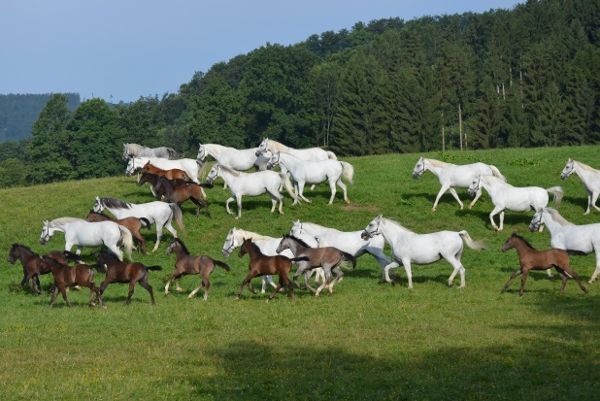Horse keeping in Austria

Horse husbandry is an important aspect of Austrian agriculture. In total, about 140,000 horses are kept in Austria, the majority of them on agricultural farms. With an overall economic impact valued at 4.15 billion euros, horses secure around 35,400 full-time jobs.
Horse Husbandry and Agriculture
Horse husbandry is an important economic factor within Austrian agriculture. The Austrian horse population is estimated at 140,000 animals (Source: Estimate Extrapolation, Frickh 2024, and Expert Survey 2024). In 2024, the horse sector in Austria generated 4.15 billion euros. The horse sector secures approximately 35,400 full-time jobs in Austria. (Source: Pferd Austria, Industrial Science Institute (IWI) – 2024).
Around 105,000 horses, or 75 percent of all horses kept in Austria, are located on agricultural farms. To supply the total population of an estimated 140,000 horses, approximately 124,000 hectares of grassland, around 100,000 tons of feed grain, and 250,000 tons of hay are required (Source: Frickh, 2024, Documentation for the Horse Industry Conference 2025). Horse farms generate added value through horse breeding and boarding, as well as through the production of specialized feed for the equine industry.
As part of the measure "Conservation of Endangered Livestock Breeds" within the Agri-Environmental Programme (ÖPUL), the endangered Noriker breed is supported.
Horse slaughtering plays a rather minor role, amounting to 64 tons (Source: Statistics Austria, 2024).
Platform PferdAustria
In 2004, the Ministry of Agriculture established the PferdAustria Platform.
Since then, numerous events on the topic of horses have been organized, and four key studies have been produced: “Economic Factor Horse,” “Social Factor Horse,” “Tourism and Leisure Factor Horse,” and “Horse and Health – Prevention and Therapy.”
Main Breeding Lines
In addition to the main breeding lines Noriker, Haflinger, Austrian Warmblood, and the world-famous Lipizzaners, a further 47 horse breeds are managed by a total of 30 recognized horse breeding associations.
The Lipizzaner, which is considered one of Europe's oldest domesticated horse breed, is frugal, enduring, docile, motivated and exceedingly good-natured. For the Spanish Riding School in Vienna, Lipizzaner stallions are bred at the Piber Federal Stud.
The Austrian Warmblood is described as noble, long-lined, correct and powerful horse with good movement and jumping abilities suited for any type of recreational riding. Despite the relatively small breeding base of 2,500 mares and 80 stallions, Austrian Warmbloods have achieved considerable success in national and international equestrian events.
The Noriker is a moderately heavy mountain draught horse that is sure-footed and has a good sense of balance. Whereas Noriker horses originally used to be workhorses and farm horses, they are now used for recreational purposes in equitation and carriage driving (horse-drawn carriages, for instance) and represent an integral part of the farming tradition.
Haflingers are chestnut-coloured impressive, modern horses with riding horse points and long white manes and tails. Their height at the withers varies between 140 and 150 cm. Originally, Haflingers were used as packhorses by mountain farmers and as cart and work horses by the military and in the agricultural sector.
Lipizzaner
The heart of Lipizzaner breeding in Piber is the broodmares: they secure the offspring for the Spanish Riding School in Vienna.
The origin of the Lipizzaner as one of the oldest cultured horse breeds in Europe dates back to the year 1580. The four-hundred-year knowledge of raising Lipizzaners is a living tradition at the Lipizzaner Stud Piber. Here, horses are bred for those specific performances for which they are particularly famous worldwide through the Spanish Riding School.
The one- to three-year-old young horses spend the summer months on the alpine pastures at 1,500 meters above sea level. This “Alping” is a very important stage in the rearing of Lipizzaners. Only by galloping and trotting over the sometimes steep and rocky slopes of the alpine pastures do they acquire the necessary surefootedness, endurance, and hardening.
The specific requirements for the Spanish Horse Riding School – Federal Stud of Piber are set forth in the Austrian Spanish Riding School Act.
Haflinger World Exhibition
Every five years, the Haflinger World Exhibition, the largest horse breed show in the world, takes place in Ebbs, Tyrol. About half of the animals are presented by members of the Haflinger Horse Breeding Association Tyrol, while the remaining Haflingers come from the member organizations of the Haflinger World Breeding & Sport Association.
Since 1947, the Haflinger Horse Breeding Association Tyrol has regularly held large international shows, and since 1990, all previous World Exhibitions have taken place every five years at the Foal Farm in Ebbs.